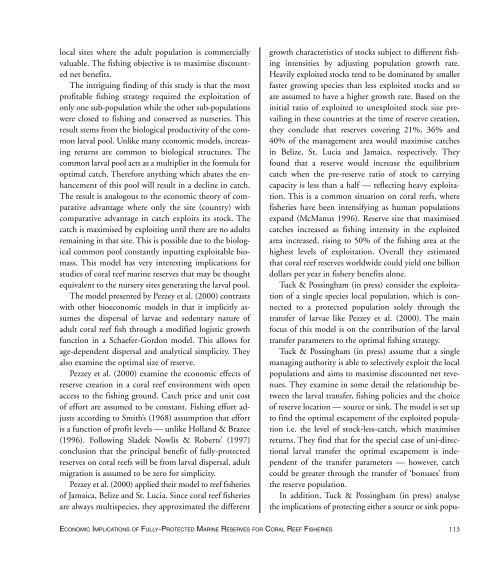Create successful ePaper yourself
Turn your PDF publications into a flip-book with our unique Google optimized e-Paper software.
local sites where the adult population is commercially<br />
valuable. The fishing objective is to maximise discounted<br />
net benefits.<br />
The intriguing finding <strong>of</strong> this study is that the most<br />
pr<strong>of</strong>itable fishing strategy required the exploitation <strong>of</strong><br />
only one sub-population while the other sub-populations<br />
were closed to fishing and conserved as nurseries. This<br />
result stems from the biological productivity <strong>of</strong> the common<br />
larval pool. Unlike many economic models, increasing<br />
returns are common to biological structures. The<br />
common larval pool acts as a multiplier in the formula for<br />
optimal catch. Therefore anything which abates the enhancement<br />
<strong>of</strong> this pool will result in a decline in catch.<br />
The result is analogous to the economic theory <strong>of</strong> comparative<br />
advantage where only the site (country) with<br />
comparative advantage in catch exploits its stock. The<br />
catch is maximised by exploiting until there are no adults<br />
remaining in that site. This is possible due to the biological<br />
common pool constantly inputting exploitable biomass.<br />
This model has very interesting implications for<br />
studies <strong>of</strong> coral reef marine reserves that may be thought<br />
equivalent to the nursery sites generating the larval pool.<br />
The model presented by Pezzey et al. (2000) contrasts<br />
with other bioeconomic models in that it implicitly assumes<br />
the dispersal <strong>of</strong> larvae and sedentary nature <strong>of</strong><br />
adult coral reef fish through a modified logistic growth<br />
function in a Schaefer-Gordon model. This allows for<br />
age-dependent dispersal and analytical simplicity. They<br />
also examine the optimal size <strong>of</strong> reserve.<br />
Pezzey et al. (2000) examine the economic effects <strong>of</strong><br />
reserve creation in a coral reef environment with open<br />
access to the fishing ground. Catch price and unit cost<br />
<strong>of</strong> effort are assumed to be constant. Fishing effort adjusts<br />
according to Smith’s (1968) assumption that effort<br />
is a function <strong>of</strong> pr<strong>of</strong>it levels — unlike Holland & Brazee<br />
(1996). Following Sladek Nowlis & Roberts’ (1997)<br />
conclusion that the principal benefit <strong>of</strong> fully-protected<br />
reserves on coral reefs will be from larval dispersal, adult<br />
migration is assumed to be zero for simplicity.<br />
Pezzey et al. (2000) applied their model to reef fisheries<br />
<strong>of</strong> Jamaica, Belize and St. Lucia. Since coral reef fisheries<br />
are always multispecies, they approximated the different<br />
growth characteristics <strong>of</strong> stocks subject to different fishing<br />
intensities by adjusting population growth rate.<br />
Heavily exploited stocks tend to be dominated by smaller<br />
faster growing species than less exploited stocks and so<br />
are assumed to have a higher growth rate. Based on the<br />
initial ratio <strong>of</strong> exploited to unexploited stock size prevailing<br />
in these countries at the time <strong>of</strong> reserve creation,<br />
they conclude that reserves covering 21%, 36% and<br />
40% <strong>of</strong> the management area would maximise catches<br />
in Belize, St. Lucia and Jamaica, respectively. They<br />
found that a reserve would increase the equilibrium<br />
catch when the pre-reserve ratio <strong>of</strong> stock to carrying<br />
capacity is less than a half — reflecting heavy exploitation.<br />
This is a common situation on coral reefs, where<br />
fisheries have been intensifying as human populations<br />
expand (McManus 1996). Reserve size that maximised<br />
catches increased as fishing intensity in the exploited<br />
area increased, rising to 50% <strong>of</strong> the fishing area at the<br />
highest levels <strong>of</strong> exploitation. Overall they estimated<br />
that coral reef reserves worldwide could yield one billion<br />
dollars per year in fishery benefits alone.<br />
Tuck & Possingham (in press) consider the exploitation<br />
<strong>of</strong> a single species local population, which is connected<br />
to a protected population solely through the<br />
transfer <strong>of</strong> larvae like Pezzey et al. (2000). The main<br />
focus <strong>of</strong> this model is on the contribution <strong>of</strong> the larval<br />
transfer parameters to the optimal fishing strategy.<br />
Tuck & Possingham (in press) assume that a single<br />
managing authority is able to selectively exploit the local<br />
populations and aims to maximise discounted net revenues.<br />
They examine in some detail the relationship between<br />
the larval transfer, fishing policies and the choice<br />
<strong>of</strong> reserve location — source or sink. The model is set up<br />
to find the optimal escapement <strong>of</strong> the exploited population<br />
i.e. the level <strong>of</strong> stock-less-catch, which maximises<br />
returns. They find that for the special case <strong>of</strong> uni-directional<br />
larval transfer the optimal escapement is independent<br />
<strong>of</strong> the transfer parameters — however, catch<br />
could be greater through the transfer <strong>of</strong> ‘bonuses’ from<br />
the reserve population.<br />
In addition, Tuck & Possingham (in press) analyse<br />
the implications <strong>of</strong> protecting either a source or sink popu-<br />
ECONOMIC IMPLICATIONS OF FULLY-PROTECTED MARINE RESERVES FOR CORAL REEF FISHERIES<br />
113


















